As publishers of this newsletter we get a lot of constructive feedback from our readers. However, once in a while we also get mails like this:
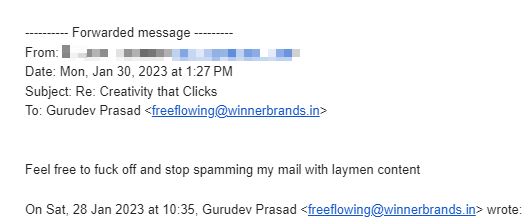
Interestingly, the gentleman above could have easily clicked the ‘Unsubscribe’ button, but the fact that he actually took out time to write a rather vicious email without offering any rationale for his outburst put us in a dilemma on how should we respond.
This got us thinking on a larger issue of how to deal with trolls.
A little research threw up an interesting finding.
The word ‘Troll’ originates from characters in ancient Nordic literature who are described as “antisocial, quarrelsome and slow-witted creatures which make life difficult for travellers”. In terms of their behaviour and impact, internet trolls aren’t too different.
Today trolls have become a common phenomenon that no entity- brands, celebrities, politicians or individuals- can stay immune from. They are considered to be an inevitable side effect of digital presence. And yet, the damage caused by trolls is real. When trolls viciously attack individuals, they can create serious mental health issues. And when they attack brands, they can harm their reputation.
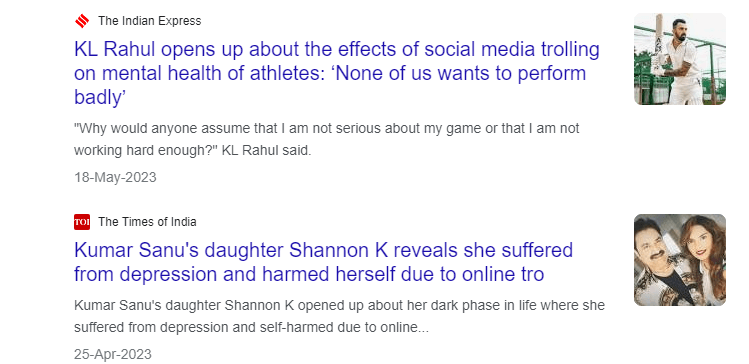
When it comes to brands in particular, an additional complication is identifying whether they are dealing with a troll or a genuine customer. After all, an aggrieved customer could also come across as angry and livid- but treating them at par with trolls would, of course, be a hara-kiri.
For instance, consider the case of Fold Money- an ‘Invite Only’ app- whose sarcastic reply to a genuine customer complaint resulted in a controversy:
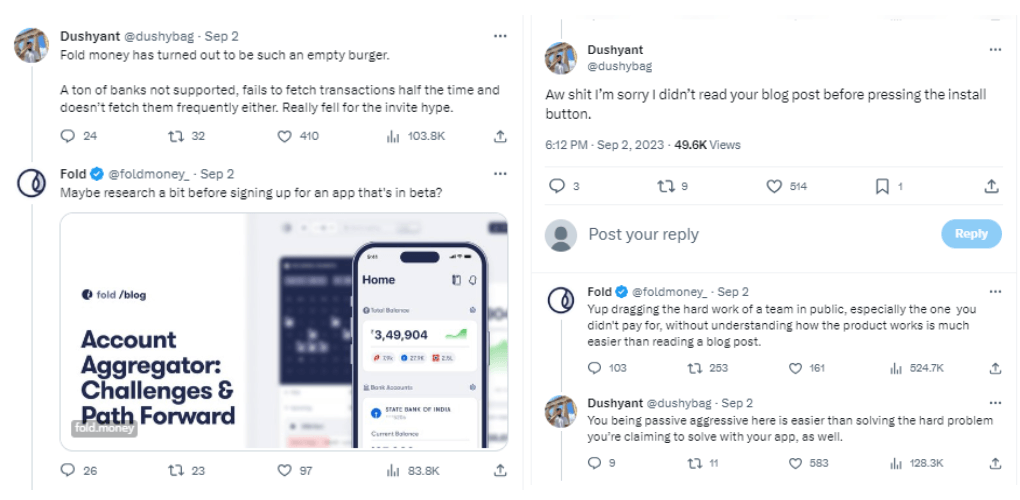
The matter escalated, with other ‘invited’ users joining in to report their poor product experience. This forced the brand to issue a clarification, with the founder coming forward to apologize for ‘poor handling’ of the situation:
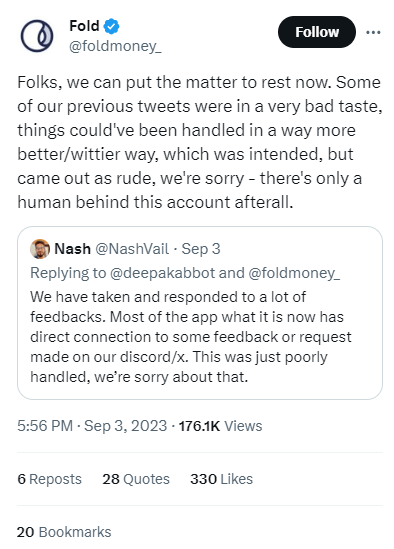
Symptoms that a brand is dealing with a troll
#1 Genuine consumers are specific, trolls are vague
While genuine consumers would typically support their complaint by specific data points that foster credibility (e.g., order ID, a specific grievance etc.), a troll’s lament is often vague, which sounds like a rant rather than a grievance.
#2 Genuine consumers have a rationale for their behaviour, trolls are irrationally bitter
A genuine consumer could come across as angry, aggrieved and in the worst case, even abusive- but their behavior is often justifiable given the issue they’ve faced. However, trolls come across as outright vengeful and bitter from the very beginning of their conversation, for no apparent reason.
#3 Genuine consumers escalate in frustration, trolls escalate to frustrate
A genuine consumer would escalate matters only when a brand fails to respond or resolve their legitimate complaint. Trolls on the other rant ad-nauseum across all channels. In order to hijack brand content, they don’t shy away from tagging founders and senior management.
#4 Genuine consumers seek closure, trolls seek attention
Genuine consumers may start off angrily, but they would generally cool down once they have let off the steam and seen the brand taking the right action. If the brand gives them a clean closure, they might even write a word of praise for the brand on public forums. Trolls on the other hand are keen to pick a fight. They don’t have a clear endgame. There is no way to satisfy them because they aren’t looking for a resolution at all.
Brands must note that, unlike disgruntled consumers, trolls have all the time and energy in the world to incessantly argue, debate and keep the issue alive. Brands must therefore ensure that they don’t FEED a troll
What FEEDS the trolls
Trolls are emboldened by below actions from the brand:
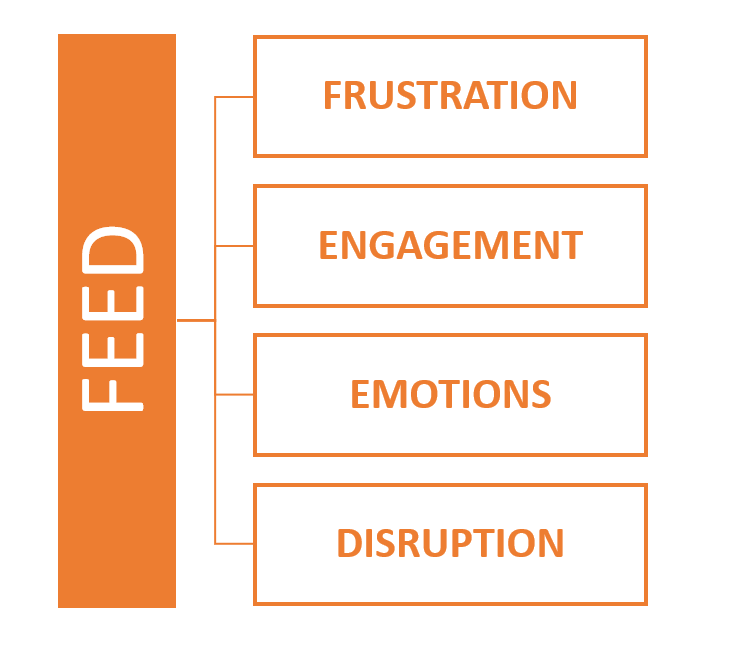
#1 Frustration
Trolls love to see the signs of frustration in a brand. Attacks of trolls are often personal (look out for words like ‘sucks’, ‘crappy’, ‘shitty’ with often personal references e.g., ‘you’, ‘your team’ etc.).
The first step in feeding trolls is indicating that someone is noticing and getting irritated by their antics. So, actions like deleting their comments or angry replies only encourage trolls to become more persistent
#2 Engagement
Another way brands might unwittingly encourage trolls is by engaging them in a conversation. This doesn’t mean that brands shouldn’t ever reply to trolls. However, they must ensure that they do not prolong this conversation. Trolls are looking for an opportunity to enter into a lengthy one-on-one spat with the brand. Opening up a 2-way conversation is their window of opportunity. Brands should not give them that
#3 Emotions
Trolls thrive in conflicts and love to rile up emotions. When brands start showing emotions in their responses or lose their sense of decorum, trolls know that they have hit the right place. Brands that do so should know that they have stepped on a slippery slope
#4 Disruption
This is the ultimate objective of troll- to cause a visible disruption. Brands apologizing to trolls, withdrawing a piece of content or changing their stance makes trolls feel victorious, and this only encourages trolls to mark the brand as a soft target for future
So, how should brands deal with trolls?
Dealing with trolls needs a calm mind and calculated action or, many times, inaction.
The most common advice for brands facing trolls is to ignore them. This is likely to frustrate the majority of trolls who decide to focus their energies somewhere else (by the way, that’s what we did in the case of the email we mentioned receiving at the start of this article).
If the brand feels it’s important to stand up to trolls and respond, the response has to be polite, professional and prim. Politely requesting facts that substantiate their rant, offering factual rebuttal or inviting them to take the conversation offline are some tactics that discourage trolls as these don’t allow them to extend the conversation and/or expose their real intentions to the public at large. Be sure not to bring emotions by snapping or reacting. For a quick primer on how to do this, try trolling Amazon Alexa 😊
It’s worth pointing out that there are also examples where brands have shut down trolls by responding to them with humour and sarcasm. In the process, they’ve even endeared themselves to their customers. Zomato in India is a good example. However, this strategy is best suited for brands well-known for their sassy tone of voice. For others, this is a risky strategy that could backfire.
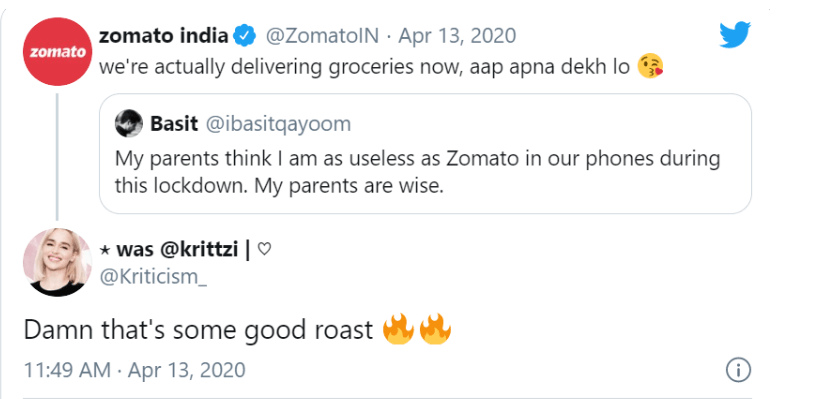
Final word: What can brands do to avoid becoming an easy target for trolls
A good product and service experience could be a potential insurance against trolls. When such brands are trolled, happy customers often defend the brand. It also works the other way around- trolls are likelier to target brands with a reputation for poor quality, bad service and unaddressed complaints. Customers may actively take the trolls’ side in such cases, precipitating a crisis.
Brands can also avoid becoming a target for trolls by discerning the trends they tap into, especially while doing moment marketing. If a brand taps into a trend that’s controversial, has tenuous linkage to the category or worse, is opposite to what it stands for, it’s inviting trolls. For a quick primer on avoiding this, refer to our article here.
Finally, training social media teams on how to recognize and respond to trolls is extremely important. Remember that the extent of damage trolls can inflict entirely depends on how a brand responds to them. Ensuring that teams are able to differentiate trolls from genuine customer complaints and frame appropriate responses will keep out trouble-makers and rabble-rousers.
Leverage the power of top marketing talent
WinnerBrands helps organizations hire top marketing talent.
Be it performance marketing experts, content specialists, creative directors, designers, video editors or brand managers, we can help you find the right marketing talent to unlock your brand’s potential.
Run by marketers for the marketers, we are already a preferred marketing talent partner for both established conglomerates and agile startups.
WinnerBrands can serve as the one-stop solution for all your marketing talent hires, offering you complete flexibility to engage this talent in your preferred engagement format-
- Full-time (on your payroll)
- Contractual (on our payroll)
- Or on a freelancing basis.
So, if you are looking to onboard the best marketing talent, vetted by industry experts, in the shortest possible time, then WinnerBrands is your go-to place.
Talk to our founders and explore smarter ways to hire marketing talent by clicking here
Cheers,
Team WinnerBrands
